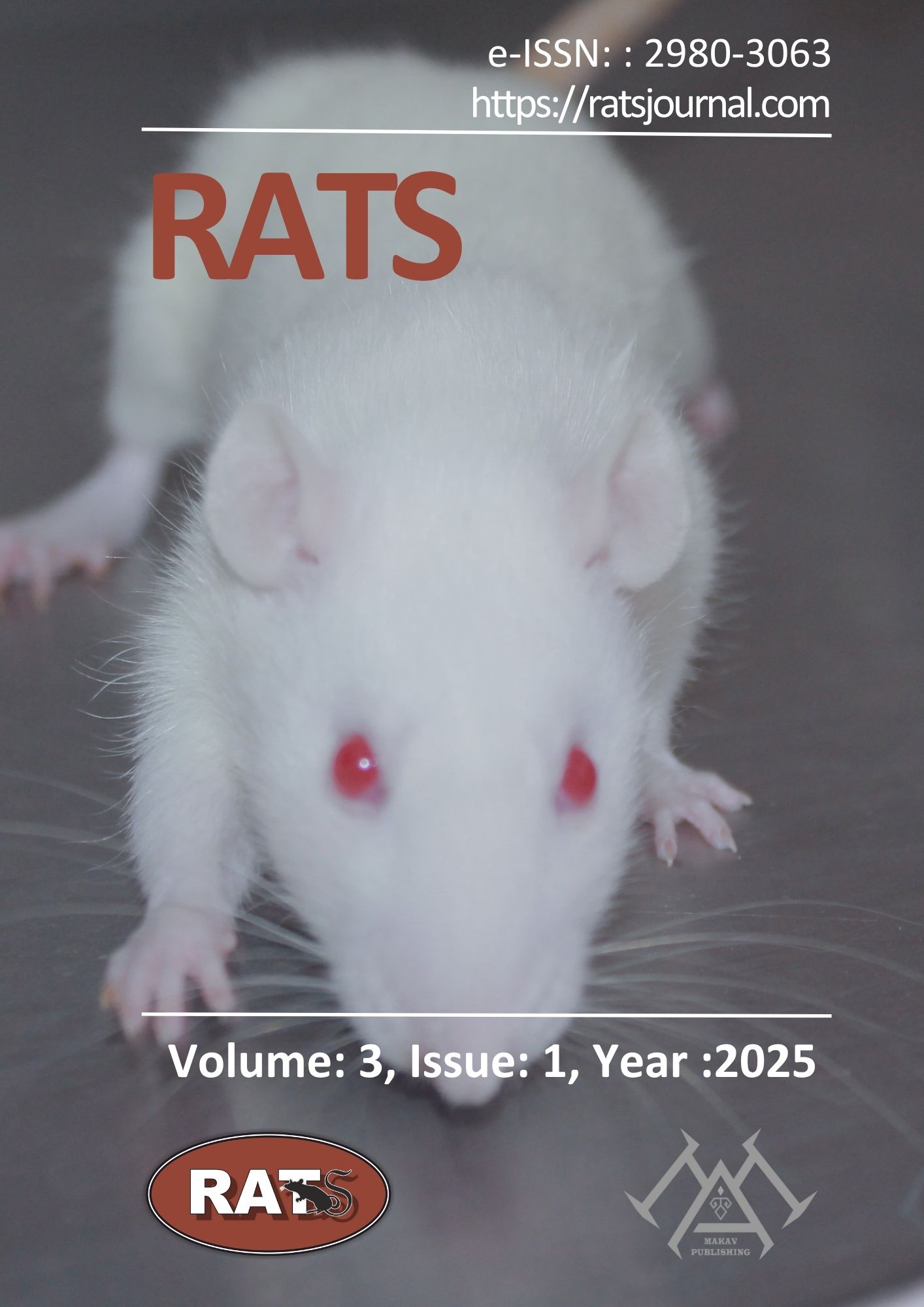Selected zoonotic diseases in rodents
DOI:
https://doi.org/10.5281/zenodo.15767462Keywords:
Infectious Diseases, Laboratory animals, Rodent, ZoonosisAbstract
Rodents, representing 43% of mammalian species, play a pivotal role in the transmission of zoonotic diseases, serving as reservoirs for pathogens including viruses, bacteria, fungi, protozoa, and helminths. Over 217 rodent species are reservoirs for 66 zoonotic diseases, such as salmonellosis, leptospirosis, toxoplasmosis, hantavirus, and Lassa fever. Prominent examples include Yersinia pestis (plague) and Borrelia burgdorferi (Lyme disease). Rodents transmit pathogens directly via bites or excreta and indirectly through food, water contamination, or vector organisms like fleas. Urbanization, migration, and habitat fragmentation amplify human-rodent interactions, increasing zoonotic risks. Rattus norvegicus and Rattus rattus, the most studied species, are primary carriers of zoonotic pathogens, harboring numerous helminths and bacteria. Brown rats dominate most of Europe, while black rats are confined to coastal areas and islands. Resistance to rodenticides and inefficient control measures exacerbate pathogen spread. Diseases like leptospirosis and hantavirus are resurging in Europe, highlighting the urgency for effective rodent control. Zoonotic pathogens include bacterial agents like Yersinia pestis and Leptospira spp., viral pathogens like hanta virus and Kyasanur Forest Disease virus, and parasitic agents such as Toxoplasma gondii. Rodents acquire pathogens via “parasite spillback” in new habitats, amplifying disease transmission risks. Effective control strategies include rodent-proof facilities, rodenticides, and antifertility agents. The global distribution and adaptability of rodents underline their central role in zoonotic disease emergence, necessitating intensified research and control measures to mitigate their impact on public health.
References
Christova I, Trifonova I, Kalvatchev N, et al. Rodents as reservoirs of human pathogens in Bulgaria. Parasites Vectors. 2014;7(1):12.
Han BA, Schmidt JP, Bowden SE, Drake JM. Rodent reservoirs of future zoonotic diseases. Proc Natl Acad Sci. 2015;112(22):7039-7044.
Dahmana H, Granjon L, Diagne C, et al. Rodents as hosts of pathogens and related zoonotic disease risk. Pathogens. 2020;9(3):202.
Meerburg B, Singleton G, Kijlstra A. Rodent-borne diseases and their risks for public health. Crit Rev Microbiol. 2009;35:221-270. https://doi.org/10.1080/10408410902989837.
Bradley C.A., Altizer S. Urbanization and the ecology of wildlife diseases. Trends Ecol Evol. 2007;22(2):95-102. https://doi.org/10.1016/j.tree.2006.11.001
Gage K.L., Kosoy M.Y. Natural history of plague: Perspectives from more than a century of research. Annu Rev Entomol. 2005;50:505-528. https://doi.org/10.1146/annurev.ento.50.071803.130337
Wells K., O’Hara R.B., Morand S., Lessard J.-P., Ribas A. The importance of parasite geography and spillover effects for global patterns of host-parasite associations in two invasive species. Divers Distrib. 2015;21(4):477-486. https://doi.org/10.1111/ddi.12297
Rabiee MH, Mahmoudi A, Siahsarvie R, et al. Rodent-borne diseases and their public health importance in Iran. PLOS Negl Trop Dis. 2018;12(4):e0006256.
Andrianaivoarimanana V, Kreppel K, Elissa N, Duplantier J.-M., Carniel E, Rajerison M, Jambou R. Understanding the Persistence of Plague Foci in Madagascar. PLoS Negl Trop Dis. 2013;7(11):e2382. https://doi.org/10.1371/journal.pntd.0002382
Pijnacker R, Goris M.G.A., Wierik M.J.M, et al. Marked increase in leptospirosis infections in humans and dogs in the Netherlands, 2014. Eurosurveillance. 2016;21(17):30211. https://doi.org/10.2807/1560-7917.ES.2016.21.17.30211
Verner-Carlsson J, Lõhmus M, Sundström K, et al. First evidence of Seoul hantavirus in the wild rat population in the Netherlands. Infect Ecol Epidemiol. 2015;5(1):27215. https://doi.org/10.3402/iee.v5.27215
Buckle A. Anticoagulant resistance in the United Kingdom and a new guideline for the management of resistant infestations of Norway rats (Rattus norvegicus Berk.). Pest Manag Sci. 2013;69(3):334-341. https://doi.org/10.1002/ps.3309
Kosoy M, Khlyap L, Cosson J.-F., Morand S. Aboriginal and invasive rats of genus Rattus as hosts of infectious agents. Vector Borne Zoonotic Dis. 2015;15(1):3-12. https://doi.org/10.1089/vbz.2014.1629
Cavia R, Cueto G.R., Suárez O.V. Changes in rodent communities according to the landscape structure in an urban ecosystem. Landscape Urban Plan. 2009;90(1):11-19. https://doi.org/10.1016/j.landurbplan.2008.10.017
Cleaveland S, Laurenson M.K., Taylor L.H. Diseases of humans and their domestic mammals: Pathogen characteristics, host range and the risk of emergence. Philos Trans R Soc Lond B Biol Sci. 2001;356(1411):991-999. https://doi.org/10.1098/rstb.2001.0889
Morand S, Bordes F, Chen H.-W., et al. Global parasite and Rattus rodent invasions: The consequences for rodent-borne diseases. Integr Zool. 2015;10(5):409-423. https://doi.org/10.1111/1749-4877.12143
Reusken C, van der Plaats R, Opsteegh M, de Bruin A, Swart A. Coxiella burnetii (Q fever) in Rattus norvegicus and Rattus rattus at livestock farms and urban locations in the Netherlands; could Rattus spp. represent reservoirs for (re)introduction? Prev Vet Med. 2011;101(1-2):124-130. https://doi.org/10.1016/j.prevetmed.2011.05.003
Chaisiri K, Siribat P, Ribas A, Morand S. Potentially Zoonotic Helminthiases of Murid Rodents from the Indo-Chinese Peninsula: Impact of Habitat and the Risk of Human Infection. Vector-Borne Zoonotic Dis. 2015;15(1):73-85. https://doi.org/10.1089/vbz.2014.1619
Swaddle J.P., Calos S.E. Increased avian diversity is associated with lower incidence of human West Nile infection: Observation of the dilution effect. PLoS One. 2008;3(6):e2488. https://doi.org/10.1371/journal.pone.0002488
Colangelo P, Abiadh A, Aloise G, et al. Mitochondrial phylogeography of the black rat supports a single invasion of the western Mediterranean basin. Biol Invasions. 2015;17(6):1859-1868. https://doi.org/10.1007/s10530-015-0842-2
Puckett E.E., Park J., Combs M., et al. Global population divergence and admixture of the brown rat (Rattus norvegicus). Proc R Soc B Biol Sci. 2016;283(1841):20161762. https://doi.org/10.1098/rspb.2016.1762
Vigne J.-D., Valladas H. Small Mammal Fossil Assemblages as Indicators of Environmental Change in Northern Corsica during the Last 2500 Years. Archaeol Sci. 1996;23(2):199-215. https://doi.org/10.1006/jasc.1996.0018
Zeng L., Ming C., Li Y., et al. Out of Southern East Asia of the Brown Rat Revealed by Large-Scale Genome Sequencing. Mol Biol Evol. 2018;35(1):149-158. https://doi.org/10.1093/molbev/msx276
Smith RH, Meyer AN. Rodent control methods: Nonchemical and non-lethal chemical, with special reference to food stores. In: Rodent Pests and Their Control. 2nd Edn. CAB International, Boston; 2015:101-122.
Parshad VR. Rodent control in India. Integr Pest Manag Rev. 1999;4(2):97-126.
Vallès X, Stenseth NC, Demeure C, et al. Human plague: An old scourge that needs new answers. PLOS Negl Trop Dis. 2020;14(8):e0008251.
Dillard RL, Juergens AL. Plague. Stat Pearls [Internet]. 2020.
Forrester JD, Apangu T, Griffith K, et al. Patterns of human plague in Uganda, 2008–2016. Emerg Infect Dis. 2017;23(9):1517-1521.
World Health Organization (WHO). Introduction to Crimean-Congo Hemorrhagic Fever. 2018 [Weblink: file:///C:/Users/k/Downloads/introduction-to-crimeancongo-haemorrhagic-fever%20(1).pdf] [Visited on 9 February 2021].
Perry RD, Fetherston JD. Yersinia pestis, etiologic agent of plague. Clin Microbiol Rev. 1997;10(1):35.
Ganapati MB. India’s pneumonic plague outbreak continues to baffle. Br Med J. 1995;311(7007):706.
Orloski KA, Lathrop SL. Plague: A veterinary perspective. J Am Vet Med Assoc. 2003;222(4):444-448. https://doi.org/10.2460/javma.2003.222.444
Fox, J. G., Newcomer, C. E., & Rozmiarek, H. Selected zoonoses. Laboratory animal medicine, 2007,1059.
Centers for Disease Control and Prevention (CDC). Human plague—Four states, 2006. MMWR Morb Mortal Wkly Rep. 2006;55(34):940-943.
Gaudie CM, Featherstone CA, Phillips WS, et al. Human Leptospira interrogans serogroup icterohaemorrhagiae infection (Weil’s disease) acquired from pet rats. Vet Rec. 2008;163(20):599-601. https://doi.org/10.1136/vr.163.20.599
Boey K, Shiokawa K, Rajeev S. Leptospira infection in rats: A literature review of global prevalence and distribution. PLOS Negl Trop Dis. 2019;13(8):e0007499.
Karpagam KB, Ganesh B. Leptospirosis: A neglected tropical zoonotic infection of public health importance—An updated review. Eur J Clin Microbiol Infect Dis. 2020;39:835-846.
Taylor AJ, Paris DH, Newton PN. A systematic review of the mortality from untreated leptospirosis. PLOS Negl Trop Dis. 2015;9(6):e0003866.
Soo ZMP, Khan NA, Siddiqui R. Leptospirosis: Increasing importance in developing countries. Acta Trop. 2019;105183.
Kumar K, Saxena VK, Thomas TG, Lal S. Outbreak investigation of scrub typhus in Himachal Pradesh (India). J Commun Dis. 2004;36(4):277-83.
Acosta-Jamett G, Martínez-Valdebenito C, Beltrami E, et al. Identification of trombiculid mites (Acari: Trombiculidae) on rodents from Chiloé Island and molecular evidence of infection with Orientia species. PLOS Negl Trop Dis. 2020;14(1):e0007619.
Devaraju P, Arumugam B, Mohan I, et al. Evidence of natural infection of Orientia tsutsugamushi in vectors and animal hosts—Risk of scrub typhus transmission to humans in Puducherry, South India. Indian J Public Health. 2020;64(1):27-31.
Varghese GM, Abraham OC, Mathai D, et al. Scrub typhus among hospitalized patients with febrile illness in South India: Magnitude and clinical predictors. J Infect. 2006;52(1):56.
Tindall BJ, Grimont PAD, Garrity GM, Euzeby JP. Nomenclature and taxonomy of the genus Salmonella. Int J Syst Evol Microbiol. 2005;55(1):521-524.
Timme RE, Pettengill JB, Allard MW et al. Phylogenetic diversity of the enteric pathogen Salmonella enterica subsp. enterica inferred from genome-wide reference-free SNP characters. Genome Biol Evol. 2013;5(11):2109-2123.
Swanson SJ, Snider C, Braden CR, et al. Multidrug-resistant Salmonella enterica serotype Typhimurium associated with pet rodents. N Engl J Med. 2007;356(1):21-28. https://doi.org/10.1056/NEJMoa060465
Percy, D. H., & Barthold, S. W. Pathology of laboratory rodents and rabbits. John Wiley & Sons, 2013
Fuller CC, Jawahir SL, Leano FT, et al. A multi-state Salmonella Typhimurium outbreak associated with frozen vacuum-packed rodents used to feed snakes. Zoonoses Public Health. 2008;55(8-10):481-487. https://doi.org/10.1111/j.1863-2378.2008.01118.x
Shah SZ, Jabbar B, Ahmed N, et al. Epidemiology, pathogenesis, and control of a tick-borne disease—Kyasanur Forest disease: Current status and future directions. Front Cell Infect Microbiol. 2018;8.
Gould EA, Solomon T. Pathogenic flaviviruses. Lancet. 2008;371(9611):500.
Mills JN, Corneli A, Young JC, et al. Hantavirus pulmonary syndrome–United States: Updated recommendations for risk reduction. MMWR Recomm Rep. 2002;51(RR-9):1-12.
Blasdell K, Cosson JF, Chaval Y, et al. Rodent-borne hantaviruses in Cambodia, Lao PDR, and Thailand. EcoHealth. 2011;8(4):432-443.
Epstein PR. Emerging diseases and ecosystem instability: New threats to public health. Am J Public Health. 1995;85(2):168.
Kolivras, K. N., & Comrie, N. C. (2004). Climate and infectious disease in the southwestern United States. Progress in Physical Geography, 28(3), 387-398.
Hangaragi PS. Hantavirus: An emerging global threat. Asian J Oral Health Allied Sci. 2020;10:4.
Lednicky JA. Hantaviruses: A short review. Arch Pathol Lab Med. 2003;127(1):30-35. https://doi.org/10.5858/2003-127-30-
Arteaga LM, Bellido JLM, Lista MCV, et al. Crimean-Congo hemorrhagic fever (CCHF) virus-specific antibody detection in blood donors, Castile-León, Spain, summer 2017 and 2018. Eurosurveillance. 2020;25(10):1900507.
Nalca A, Whitehouse CA. Crimean-Congo hemorrhagic fever virus infection among animals. In: Crimean-Congo Hemorrhagic Fever. 2007:155-165.
Ergonul O. Crimean-Congo hemorrhagic fever. Lancet Infect Dis. 2006;6(4):203.
Zohaib A, Saqib M, Athar MA, et al. Crimean-Congo hemorrhagic fever virus in humans and livestock, Pakistan, 2015–2017. Emerg Infect Dis. 2020;26(4):773.
Nicolle C, Manceaux L. Sur une infection à corps de Leishman (ou organismes voisins) du gondi. CR Acad Sci. 1908;147:736
Dubey J.P. The history of Toxoplasma gondii—the first 100 years. J Eukaryot Microbiol. 2008;55:467-475.
Rahimi M.T., Daryani A, Sarvi S, Shokri A, Ahmadpour E, Teshnizi S.H., et al. Cats and Toxoplasma gondii: a systematic review and meta-analysis in Iran. Onderstepoort J Vet Res. 2015;82:823.
Galeh TM, Sarvi S, Montazeri M, et al. Global status of Toxoplasma gondii seroprevalence in rodents: A systematic review and meta-analysis. Front Vet Sci. 2020;7.
Slavin M.A., Meyers J.D., Remington J.S., Hackman R.C. Toxoplasma gondii infection in marrow transplant recipients: a 20 year experience. Bone Marrow Transplant. 1994;13:549-557.
Belluco S, Mancin M, Conficoni D, Simonato G, Pietrobelli M, Ricci A. Investigating the determinants of Toxoplasma gondii prevalence in meat: a systematic review and meta-regression. PLoS One. 2016;11:e0153856.
Torgerson P.R., Mastroiacovo P. The global burden of congenital toxoplasmosis: a systematic review. Bull World Health Organ. 2013;91:501-508.
OIE. Toxoplasmosis [Weblink: https://www.oie.int/fileadmin/Home/eng/Health_standards/tahm/2.09.09_TOXO.pdf] [Visited on 28 January 2021].
Robert-Gangneux F, Darde M.L. Epidemiology of and diagnostic strategies for toxoplasmosis. Clin Microbiol Rev. 2012;25:264-296.
Halonen SK, Weiss LM. Toxoplasmosis. In: Handbook of Clinical Neurology. 2013;114:125-145.
Ahmadpour E, Daryani A, Sharif M, Sarvi S, Aarabi M, Mizani A, et al. Toxoplasmosis in immunocompromised patients in Iran: a systematic review and meta-analysis. J Infect Dev Ctries. 2014;8:1503-1510.
Weiss L.M., Dubey J.P. Toxoplasmosis: a history of clinical observations. Int J Parasitol. 2009;39:895-901.
Majidiani H, Dalvand S, Daryani A, Galvan-Ramirez M.L., Foroutan-Rad M. Is chronic toxoplasmosis a risk factor for diabetes mellitus? A systematic review and meta-analysis of case-control studies. Braz J Infect Dis. 2016;20:605-609.
Sutterland A.L., Fond G., Kuin A., Koeter M.W., Lutter R., van Gool T., et al. Beyond the association. Toxoplasma gondii in schizophrenia, bipolar disorder, and addiction: systematic review and meta-analysis. Acta Psychiatr Scand. 2015;132:161-179.
Foroutan-Rad M, Khademvatan S, Majidiani H, Aryamand S, Rahim F, Malehi A.S. Seroprevalence of Toxoplasma gondii in the Iranian pregnant women: a systematic review and meta-analysis. Acta Trop. 2016;158:160-169.
Dehghani R., Arzanian M.T., Mohammadi M., Faramarzi M.A. Toxoplasma gondii infection in wild rodents in Iran. J Vet Med Sci. 2013;75:319-325.
Kijlstra A, Meerburg B, Cornelissen J, et al. The role of rodents and shrews in the transmission of Toxoplasma gondii to pigs. Vet Parasitol. 2008;156(3-4):183.
Downloads
Published
How to Cite
Issue
Section
License
Copyright (c) 2025 Rats

This work is licensed under a Creative Commons Attribution 4.0 International License.


















